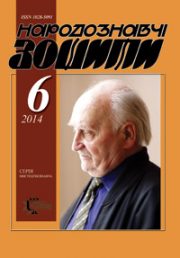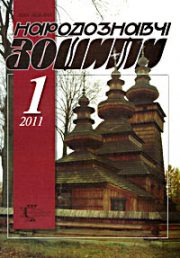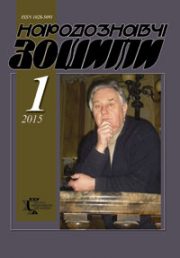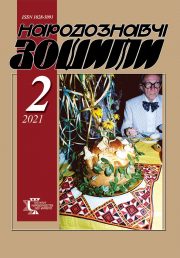The Ethnology Notebooks. 2021. № 3 (159), 621—629
UDK 398.47(477.82)
DOI https://doi.org/10.15407/nz2021.03.621
TRADITIONAL WAYS OF PROTECTING FROM WITCHES IN THE CALENDAR RITUALS OF VOLHYNIANS
KRYVENKO Anastasiia
- ORCID ID: https://orcid.org/0000-0001-9353-2919
- Candidate of Sciences in History, Senior Researcher,
- the Institute of Ethnology of the National
- Academy of Sciences of Ukraine,
- The Department of Modern Ethnology,
- 15, Svobody Avenue, 79000, Lviv, Ukraine
- Contacts: е-mail: n.d.kryvenko@gmail.com
Abstract. According to ethnographic sources of the XIX—XX centuries and materials of modern field research in the article it is analyzed the worldview and rite expression of the ritual and mythological motives of «fighting with witches» in the calendar custom of the Volhynians. Author describes traditional methods of magical neutralization of witchcraft bearers, averting and preventing from their magic. It is also shown the occurrence of rituals, its local variants and explained to what extent ancient ritual practices and demonological beliefs are retained on the territory of Volhynia nowadays.
The study of the general ethnic features and local specialty of magic neutralizing the withes represented in the calendar tradition of the residents of the ethnographic Volyn is the actual task in modern ethnological science.
The object of the research is calendar rituals of Volyn, and the subject — warnings, prohibitions, protective rites in the folk calendar, defined by demonological notions about witches.
According to the comparative analysis and the use of various methods (field observation, typological analysis, structural-functional, comparative-historical, reconstructive, structural-semantic) allowed to conclude that some apotropaical practices belong to those ethno-local customs and ritual phenomena, which are clearly emphasized in the calendar tradition of the inhabitants of ethnographic Volhynia. At the same time, many of the other means of protection against witches have an all-Ukrainian, another-ethnic equivalents and typological parallels in family, construction, agrarian rituals. Their further ethnological study is scientifically promising for a holistic and in-depth research of the entire field of folk rituals.
Keywords: witch, calendar customs and rituals, beliefs, protective magic, apotropaic objects.
Received 2.06.2021
REFERENCES
- Kryvenko, A. (2020). Folk demonology of Volhynia: calendar and ritual context. Lviv [in Ukrainian].
- Kryvenko, A. (2015). On the image of witch in the midsummer days beliefs in Volhyn. The Ethnology notebooks, 2, 463—475 [in Ukrainian].
- Dymnycz, N. (1930). Rituals and folk beliefs during Christmas time. In Rocznik Wolynski (Vol. 1, pp. 94—106). Rowne [in Polish].
- Kravchenko, V. (1941). Collection of ethnographic and folklore materials. Records from different collectors: Folks calendar. NANF IMFE NAS of Ukraine (National archival scientific collections of manuscripts and phonographs of the M.T. Rylsky Institute of Art, Folklore Studies and Ethnology of the NAS of Ukraine). F. 15. Act. 256 (V.). Arc. 1—193 [in Ukrainian].
- Pasternak, Ya. (1929). Customs and beliefs in the Zibolky of Zhovkwa region. Materiialy do etnolohii j antropolohii (Vol. 21—22, issue 1, pp. 321—352). Lviv [in Ukrainian].
- Pukivs’kyj, Yu. (2015). Spring calendar rituals of Ukrainians of the historical and ethnographic Volhynia. Lviv [in Ukrainian].
- Folklore and ethnographic materials collected by individual correspondents in the Zhytomyr region (1923—1930). NANF IMFE NAS of Ukraine. F. 1—7. Act. 721. Arc. 1—147 [in Ukrainian].
- Kravchenko, V. (1941). Collection of ethnographic and folklore materials. Records from different collectors: Folks calendar. NANF IMFE NAS of Ukraine. F. 15. Act. 257 (VI). Arc. 1—186 [in Ukrainian].
- Kravchenko, V. (1928). From the life and ceremonies of the northwestern Ukraine. In Volyn Research Museum (Vol. 1, pp. 67—114). Zhytomyr [in Ukrainian].
- Kryvenko, A. (2013). Field ethnographic materials on the theme «Calendar layer of Volyn demonology», recorded by Kryvenko Anastasiia Oleksandrivna in August`6—11, 2013 in the Sokal district of Lviv region and Ivanychiv district of Volyn region. Archive of the Ivan Franko LNU. F. R-119. Op. 17. Act. 497-E. Arc. 1—80 [in Ukrainian].
- Kryvenko, A. (2014). Calendar customs and beliefs of the Volynians. Field materials collected in the villages of Khmelnytsky district of Vinnytsia region, Starokostiantynivsky and Bilogirsk districts of the Khmelnytsky region, Lanovets district of the Ternopil region. Archive of the IN NANU (Archive of the Institute of Ethnology of the National Academy of Sciences of Ukraine). F. 1. Op. 2. Od. save 737. Arc. 1—283 [in Ukrainian].
- Kryvenko, A. (2013). Field ethnographic materials on the theme «Calendar layer of Volyn demonology», recorded by Kryvenko Anastasiia Oleksandrivna in July 3—15, 2013 in Chernyakhiv, Chervonoarmijsk, Volodar-Volynsk districts of Zhytomyr region. Archive of the Ivan Franko LNU. F. R-119. Op. 17. Act. 496-E. Arc. 1—122 [in Ukrainian].
- Halajchuk, V. (2012). Demonology of the Kremenets region. Visnyk of the Lviv University. Historical Series, 47, 198—240 [in Ukrainian].
- Kaminsky, V. (1906). Easter holiday in the village of Kosarevo, Dubensk district, Volyn region. Kievskaja starina (Vol. 92, book 3—4, pp. 299—320) [in Russian].
- Duda, O. (2009). Field ethnographic materials on the theme «Spring calendar rituals», recorded by Duda Olga Ivanivna on July 4—15, 2009 in Hoschansky district of Rivne region. Archive of the Ivan Franko LNU. F. R-119. Op. 17. Act. 285-E. Arc. 1—56 [in Ukrainian].
- Duda, O. (2010). Field ethnographic materials on the topic «Spring calendar rituals», recorded by a third-year student Duda Olga Ivanivna July 5—20, 2010 in Gorokhiv district of Volyn region. Archive of the Ivan Franko LNU. F. R-119. Op. 17. Act. 334-E. Arc. 1—77 [in Ukrainian].
- Kryvenko, A. (2010). Field ethnographic materials on the theme «Demonology», recorded by Kryvenko Anastasiia Oleksandrivna on July 5—20, 2010 in Gorokhovsky district of the Volyn region. Archive of the Ivan Franko LNU. F. R-119. Op. 17. Act. 337-E. Arc. 1—53 [in Ukrainian].
- Ben’kovskij, I. (1895). Customs and beliefs timed to «Easter». Kievskaja starina (Vol. 49, b. 5, pp. 70—76) [in Russian].
- Plotnikova, A. (1995). The first pasture of cattle in Polesie. In Slavic and Balkan folklore. Ethnolinguistic study of Polesie (Pp. 108—141). Moskow [in Russian].
- Materials for the study of livestock in Ukraine, customs, signs, treatment of livestock. NANF IMFE NAS of Ukraine. F. 15—3. Act. 216. Arc. 1—60 [in Ukrainian].
- Kryvenko, A. (2015). Calendar customs and beliefs of the Volynians. Field materials collected in the villages of Busk and Brody district of the Lviv region). Archive of the IN NANU. F. 1. Op. 2. Od. save 773. Arc. 1—109 [in Ukrainian].
- Bahlaj, M. (2013). On ritual functions of Trinitarian flora in Volhynians (after ethnographic materials of 2009—2011 expeditions). The Ethnology notebooks, 4, 606—615 [in Ukrainian].
- Benkovskij, I. (1898). Aspen in beliefs and in the concept of the people in Volhynia. Kievskaja starina (Vol. 62, b. 7—8, pp. 6—9) [in Russian].
- Bahlaj, M. (2015). Pastoral motives in summer ritualism of volhynians in Zhytomyr region. The Ethnology notebooks, 4, 818—824 [in Ukrainian].
- Domanytskyj, V. (1912). Folk calendar in Rivne district, Volhynia region (Vol. 15, pp. 62—89). Lviv [in Ukrainian].
- Parkhomenko, T. (2005) Traditional rituals of Ivan Kupala day of Rivne region. Scientific notes of the Rivne Regional Museum of Ukrainian studies (Issue 3, pp. 98—105). Rivne [in Ukrainian].
- Rokossowska, Z. (1889). About the plant world, imagination, beliefs and the administration of the Ruthenian people in Volynia, in the village of Jurkowszczyzna, the Zwiahelski poviat. Zbior wiadomosci do antropologii krajowej (Vol. 13, pp. 163—199) [in Polish].
- Stecki, Т. (1864). Volyn pod wzgledem statystycznym, historycznym i archeologicznym (Vol. 1). Lwow [in Polish].
- Yankovska, Zh. (2012). Kupala songs and specifics of Ivan Kupala’s holiday in Slavutych region (Lysyche village, Slavutych district, Khmelnytsky region). Materials to the Ukrainian ethnology, 11, 79—84 [in Ukrainian].
- Kolodiuk, A. (2015). The rituals and songs of the middsummer («kupalo»-«petrivka») period (based on the average watershed Goryn and Slush). Problemy etnomuzykolohii: Naukovo-metodychnyj zbirnyk, 10, 104—123 [in Ukrainian].
- Bahlaj, M. (2010). Field ethnographic materials on the theme «Summer calendar ritual of Volhynians», recorded by Baglaj Marya Vasylivna on July 5—20, 2010 in Gorokhivsky district of Volyn region. Archive of the Ivan Franko LNU. F. R-119. Op. 17. Act. 330-E. Arc. 1—205 [in Ukrainian].
- Agapkina, T. (2004). Bathing. In Slavjanskie drevnosti: etnolingvisticheskij slovar’ (Vol. 3, pp. 49—51). Moskva [in Russian].
- Horoshko, L. (2010). «The Devil is afraid of Fire but dwells in Water» (The Ukrainians’ Traditional Notions of Water as a Site of Mythological Creatures). The Ethnology notebooks, 5—6, 566—574 [in Ukrainian].
- Kopernicki, I. (1887). A contribution to the ethnography of the Ruthenian people in Volynia from the materials collected by P. Zofia Rokossovska in the village of Jurkowshchyzna in the Zwiahel poviat. Zbior wiadomosci do antropologii krajowej (Vol. 11, pp. 130—228) [in Polish].
- Bahlai, M. (2014). Byrb customs and rites of the Volynians of the Goshcha region. Naukovi zapysky Rivnens’koho oblasnoho kraieznavchoho muzeiu (Issue 12, part 2, pp. 5—8). Rivne [in Ukrainian].
- Bahlaj, M. (2009). Field ethnographic materials on the theme «Summer calendar ritual of Volhynians», recorded by Baglaj Marya Vasylivna on July 4—14, 2009 in Hoscha and Ostroh districts of Rivne region. Archive of the Ivan Franko LNU (Archive of the Ivan Franko National University of Lviv). F. R-119. Op. 17. Act. 281-E. Arc. 1—99 [in Ukrainian].
- Kravchenko, V. (1911). Ethnographic materials collected by V. Kravchenko in Volyn and in other provinces. In Proceedings of the Society of Volyn Researchers (Vol. 5). Zhytomyr [in Ukrainian].
- Hnatiuk, V. Bathing and burning witches in Galicia. In Materiialy do ukrains’koi etnol’ogii (Vol. 15, pp. 178—201). L’viv [in Ukrainian].
- Malinka, A. (1894). Tales obout witches. Kievskaja starina (Vol. 64, book 3, pp. 551—553) [in Russian].
- Kurochkin, O. (1990). Witch in the Ukrainian mythological tradition. Narodna tvorchist’ ta etnohrafiia, 4, 23—29 [in Ukrainian].
- Boriak, O. (2009). The Midwife in the Cultural and Historical Traditions of the Ukrainians: Between the Ordinary and the Sacred. Kyiv [in Ukrainian].
- Tyvodar, M. (1994). Traditional cattle breeding of the Ukrainian Carpathians of the second half of the XIX — first half of the XX century. Historical and ethnological research. Uzhhorod [in Ukrainian].
- Pavliuk, S. (2006). Agrarian traditions. In Ethnogenesis and ethnic history of the population of the Ukrainian Carpathians (Vol. 2, pp. 11—56). Lviv [in Ukrainian].
- Siletsky, R. (2011). Traditional building ritualism of the Ukrainians. Lviv [in Ukrainian].
- Biegeleisen, H. (1929). At a cradle. Before oltar. Above mogila. Lviv [in Polish].
- Kryvenko, A. (2017). The motive of witch recognition in the calendar and ritual tradition of Volhynians. The Ethnology notebooks, 4, 859—866 [in Ukrainian].
- Krylovets’, N. (2008). Abyss. Stories and legends. Rivne [in Ukrainian].
- Sokalski, B. (1899). Sokal of poviat in the geographic, ethnographic, historical and economic terms. Lviv [in Polish].
- Halajchuk, V. (2016). Ukrainian mythology. Kharkiv: Klub simejnoho dozvillia [in Ukrainian].
- Vojtovych, N. (2015). Folk demonology of Boykivshchyna. L’viv [in Ukrainian].
- Holovakha, I. (1995). «A witch’s cow is always good». Traditional stories
- about witches and the myth-making worldview of modern human. Modernity, 5, 103—108 [in Ukrainian].
- Ivanov, P. (1991). Folk tales about witches and vampires. In Ukraintsi: narodni viruvannia, povir’ia, demonolohiia (Pp. 430—497). Kyiv [in Russian].
- Tolstaja, S. (1994). Between two worlds: magical ways of recognizing a witch. In Myth and culture: Human — not human (Pp. 9—13). Moskow [in Russian].







